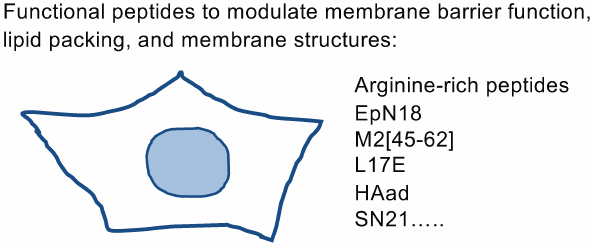- 著者
- Kenichi Kawano Fumiaki Yokoyama Kouhei Kamasaka Jun Kawamoto Takuya Ogawa Tatsuo Kurihara Shiroh Futaki
- 出版者
- The Pharmaceutical Society of Japan
- 雑誌
- Chemical and Pharmaceutical Bulletin (ISSN:00092363)
- 巻号頁・発行日
- vol.69, no.11, pp.1075-1082, 2021-11-01 (Released:2021-11-01)
- 参考文献数
- 38
- 被引用文献数
- 4
Extracellular vesicles (EVs) have emerged as important targets in biological and medical studies because they are involved in diverse human diseases and bacterial pathogenesis. Although antibodies targeting the surface biomarkers are widely used to detect EVs, peptide-based curvature sensors are currently attracting an attention as a novel tool for marker-free EV detection techniques. We have previously created a curvature-sensing peptide, FAAV and applied it to develop a simple and rapid method for detection of bacterial EVs in cultured media. The method utilized the fluorescence/Förster resonance energy transfer (FRET) phenomenon to achieve the high sensitivity to changes in the EV amount. In the present study, to develop a practical and easy-to-use approach that can detect bacterial EVs by peptides alone, we designed novel curvature-sensing peptides, N-terminus-substituted FAAV (nFAAV) peptides. The nFAAV peptides exerted higher α-helix-stabilizing effects than FAAV upon binding to vesicles while maintaining a random coil structure in aqueous solution. One of the nFAAV peptides showed a superior binding affinity for bacterial EVs and detected changes in the EV amount with 5-fold higher sensitivity than FAAV even in the presence of the EV-secretory bacterial cells. We named nFAAV5, which exhibited the high ability to detect bacterial EVs, as an EV-sensing peptide. Our finding is that the coil–α-helix structural transition of the nFAAV peptides serve as a key structural factor for highly sensitive detection of bacterial EVs.
- 著者
- Shiroh Futaki
- 出版者
- The Pharmaceutical Society of Japan
- 雑誌
- Chemical and Pharmaceutical Bulletin (ISSN:00092363)
- 巻号頁・発行日
- vol.69, no.7, pp.601-607, 2021-07-01 (Released:2021-07-01)
- 参考文献数
- 57
- 被引用文献数
- 10
Biomembranes are important targets in molecular design. Our laboratory has been exploring the design of functional peptides that modulate membrane barrier function, lipid packing, and structure. Evaluation of the results obtained and analyses of cellular mechanisms have yielded peptides with more refined designs and functions. This review highlights the progress made in our laboratory towards the development of unique peptides that modulate membrane properties.

